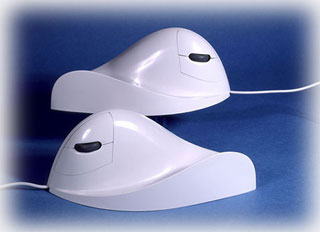Computer Health - Quill Mouse

There are thousands upon thousands of people, mostly women, who everyday are physically wearing their hands out through using computer mice. Computer manufacturers ignore the issues and ergonomic experts attribute RSI to psychosomatics, hormone cycles and other circumstance that people can't change, placing the blame on the 'design of the Titanic', with no mention of the iceberg, the computer mouse! It develops in most people in their mousing arm; keyboarding is less of a problem because you generally keep your hands moving. We have developed a mouse that removes all of the wear causing activity by being grip-less and click-less. We do not have a computer expert amongst, we are mostly from clinical backgrounds and we bend plastic to make mice so we can straighten people's hands.
Mechanical onset RSI (MoRSI) as we call it is as a result of predictable mechanical consequences. Only by understanding the mechanics involved will it mostly be avoided.
The Mechanics of Mousing: (or, Why is MoRSI a surprise?)
A 1-ounce load applied by the thumb tip, is equivalent to 10 ounces of force applied at the CMC (thumb/palm) joint. If applied for 3 hours a day it is equal to 6,750 lbs of force moving through that joint (that is if the entire day's effort were performed in 1 second the equivalent force applied would be 6,750 lbs) or 750 tons a year on a 222 day working year. Fingers click mouse buttons some 1,000,000 - 2,000,000 a year (3,000 to 5,000 a day for a professional typist or when web surfing). Moving the mouse 2 inches between 2,000,000 clicks is to travel 63 miles a year over a mouse mat. Throw in static posture, twisted wrists and constant muscular tension from gripping, creating poor circulation and likely periods of hypoxia and you start to understand why it hurts.
Mice require grip, trackballs immobilize arms, wrists on wrist rests bear their own weight on the point where blood vessels are closet to the skin, (where the pulse is taken) all helping to cut off blood supply. The best current advice is to maintain arm mobility to promote circulation by using upper arm muscles to point the cursor, maintain a neutral posture and don't grip. The following is an excerpt, the link to the full information supplied.
The American Academy of Orthopaedic Surgeons advice on preventing CTS.
(Full document at http://www.pl.net/9.3health/precar.htm)
Other reading:
http://www.quillmouse.com/Computer_Mouse_Fatigue.pdf
Our website is www.quillmouse.com
MORE





